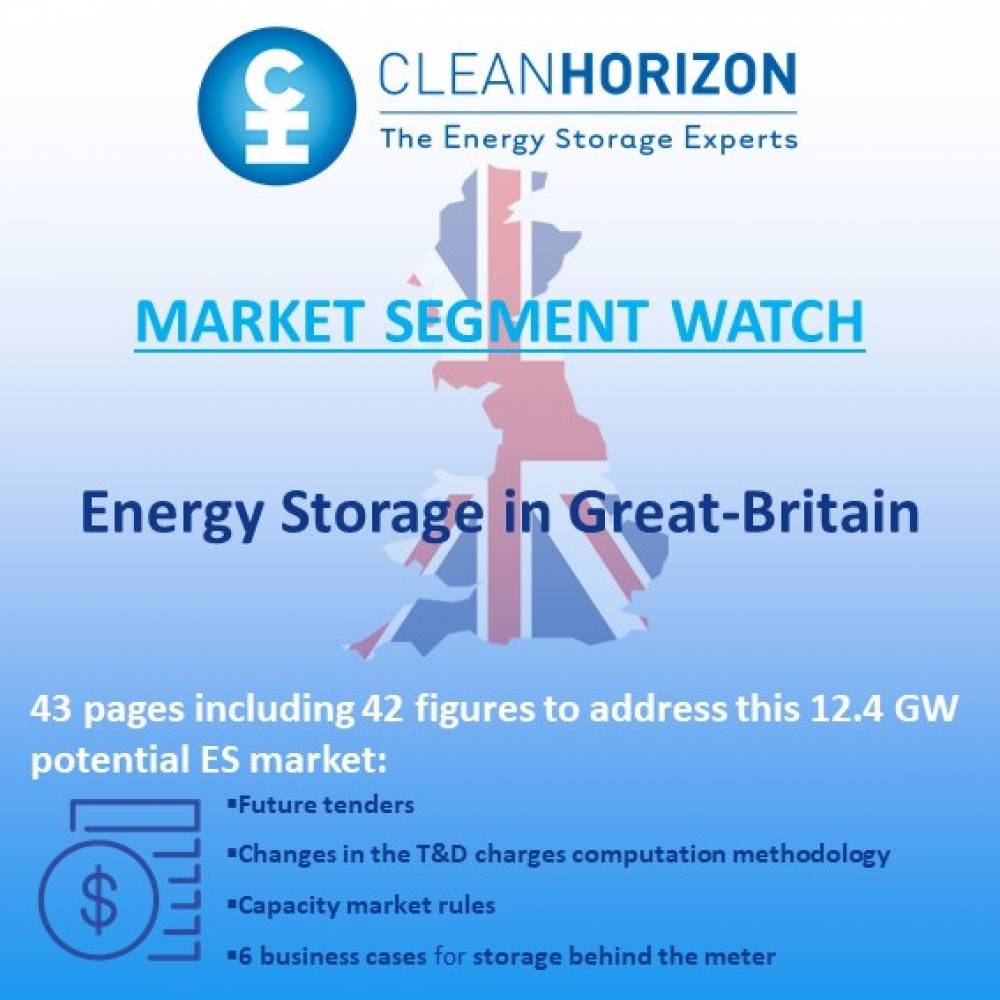Market Segment Watch Great-Britain 2017
1500 €
Get fresh insights into the largest Energy Storage market in Europe and find how to profit from the current regulatory changes.
Description
Key questions adressed:
- How does the GB energy market work?
- What are the revenue streams for energy storage assets?
- How can energy storage systems stack revenue streams?
- What are the emerging business cases for energy storage projects in GB?
Who needs this report?
- Energy storage equipment manufacturers
- Integrators looking at the GB market
- Project developers willing to better understand the GB market
- Investors willing to better understand the risks associated with storage and the revenue streams
- Utilities looking for opportunities with energy storage
- Commercial and industrial electricity consumers
TABLE OF CONTENTS
Introduction
1. Grid services available for energy storage systems
1.1. Existing frequency regulation services
1.2. Evolutions in the frequency regulation services
1.3. The capacity market: evolution and opportunity for storage
1.3.1. Objectives and capacity market rules
1.3.2. Past capacity T-4 auctions
1.3.3. Future auctions and potential rule changes
1.4. Reduction of the electricity bills of commercial and industrial consumers
1.4.1. Transmission use of system charges
1.4.2. Distribution use of system charges
1.5. Other complementary revenues for storage to watch
1.5.1. Flexibility services to the DNOs
1.5.2. Balancing Mechanism (BM)
1.5.3. Short Term Operating Reserve (STOR)
1.5.4. Demand Turn Up (DTU)
2. The business case for energy storage systems behind the meter
2.1. Business case 1: energy storage to reduce the electricity bill of C&I customers
2.1.1. Transmission fees avoidance (TNUoS)
2.1.2. Distribution fees avoidance (DUoS)
2.1.3. Building the business case for storage behind the meter of C&I
2.2. Business case 2: storage to increase renewables self-consumption for C&I customers
2.2.1. Current business case for PV plus storage behind the meter of C&I
2.2.2. Analysis of a scenario with a higher electricity retail price
2.3. Business case 3: energy storage behind the meter of residential customers
2.3.1. Current business case for residential PV + storage
2.3.2. Potential future business cases for residential PV plus storage
3. The future market for energy storage in Great Britain
3.1. Assessment of the future grid needs regarding flexibility and share of storage
3.1.1. Future need for frequency response
3.1.2. Committed projects and next bidding strategies
3.2. Future deployment of energy storage behind the meter
3.2.1. Storage to reduce the electricity bill of C&I customers
3.2.2. Market size or number of customers exposed to high transmission and demand charges
3.3. Storage for PV self-consumption
3.4. Market for energy storage in Great Britain in 2025
TABLE OF FIGURES
Figure 1: Gross UK generation mix evolution from 2012 to 2016
Figure 2: Illustration of some existing frequency regulation services in Great Britain
Figure 3: Timetable set by National Grid to review its balancing services
Figure 4: Three key steps for National Grid to create a level playing field for balancing services market
Figure 5: Two potential future designs for the ancillary services market: single market VS standardisation
Figure 6: De-rating factors for the 2016 T-4 auction by technology class
Figure 7: Capacity market auctions: volumes, delivery years and clearing prices
Figure 8: Triad periods for the winter 2016/17
Figure 9: Transmission zones and fees for the year 2016/17 (National Grid)
Figure 10 Forecasted evolution of the embedded benefits and compound annual growth rate (CAGR)
Figure 11: Schedule of charges for HH metered properties by WPD in the South West
Figure 12: Expected changes trend for HH metered customers in the distribution charges
Figure 13: WPD ENTIRE project characteristics in the East Midlands
Figure 14: Imbalance price and net imbalance volume by settlement period on 29/06/2016
Figure 15: Balancing market-net imbalance volume (long and short system) in February 2017
Figure 16: Historical and expected demand tariff for TNUoS charges
Figure 17: Consequences of residual transmission charges methodology for energy storage systems
Figure 18: Low voltage HH metered DUoS unit charge in different regions in 2017 (in p/kWh)
Figure 19: Business cases and scenarios addressed in section 2
Figure 20: Business case 1.1 for a 1MW/1MWh storage project behind the meter to reduce network charges
Figure 21: Business case 1.2 for a 1MW/1MWh storage project behind the meter in 2020
Figure 22: Required revenues from TNUoS charges avoidance for a storage system to break through in 2020
Figure 23: Business case 1.3 for a 1MW/1MWh storage project behind the meter in 2020
Figure 24: Consumption profile of a commercial customer and PV plus storage use
Figure 25: Business case 2.1 for a 100kW/100kWh coupled with a 700kWp PV system
Figure 26: Business case 2.2 for a 100kW/100kWH storage system couple with a 700kWp solar panel
Figure 27: Current business case for a residential customer to install a PV plus storage system
Figure 28: First scenario – optimistic future business case for residential PV plus storage
Figure 29: Second scenario – pessimistic future business case for residential PV plus storage
Figure 30: Great Britain future need for frequency response
Figure 31: Future requirement for primary or equivalent sub-second response requirement
Figure 32: Capacity market agreements and EFR contracts awarded to energy storage
Figure 33: Future requirement for sub-second response and committed energy storage capacity (in MW)
Figure 34: Non-HH metered profile classes and their characteristics as of February 2017
Figure 35: Breakdown of energy users by metering type as of December 2012
Figure 36: Breakdown of energy users by metering type as of February 2017
Figure 37: Number of HH metered consumers and annual energy imported
Figure 38: Total addressable markets for energy storage behind the meter of C&I
Figure 39: Assumptions to compute the total addressable market for energy storage behind the meter of C&I
Figure 40: Solar installations behind the meter in Great Britain under the feed in tariff scheme
Figure 41: PV export and generation feed in tariff from 2010 to present for new small installations
Figure 42: Different total addressable markets for mature energy storage applications in GB in 2017
